Haitians say the violence and economic stagnation stemming from a clash between the president and the opposition are worse than anything they have ever experienced.
By Kirk Semple, The New York Times —
LÉOGÂNE, Haiti — The small hospital was down to a single day’s supply of oxygen and had to decide who would get it: the adults recovering from strokes and other ailments, or the newborns clinging to life in the neonatal ward.
Haiti’s political crisis had forced this awful dilemma — one drama of countless in a nation driven to the brink of collapse.
A struggle between President Jovenel Moïse and a surging opposition movement demanding his ouster has led to violent demonstrations and barricaded streets across the country, rendering roads impassable and creating a sprawling emergency.
Caught in the national paralysis, officials at Sainte Croix Hospital were forced to choose who might live and who might die. Fortunately, a truck carrying 40 fresh tanks of oxygen made it through at the last minute, giving the hospital a reprieve.
“It was scary, really scary,” said Archdeacon Abiade Lozama of the Episcopal Church of Haiti, which owns the hospital. “Every day, things become more difficult, day after day.”
Though the country has been trapped for years in cycles of political and economic dysfunction, many Haitians say the current crisis is worse than anything they have ever experienced. Lives that were already extremely difficult, here in the poorest country in the Western Hemisphere, have become even more so.
Weeks of unrest around Haiti, coupled with rampant corruption and economic malaise, have led to soaring prices, a disintegration of public services and a galloping sense of insecurity and lawlessness. At least 30 people have been killed in the demonstrations in the past few weeks, including 15 by police officers, according to the United Nations.
“There is no hope in this country,” said Stamène Molière, 27, an unemployed secretary in the southern coastal town of Les Cayes. “There’s no life anymore.”
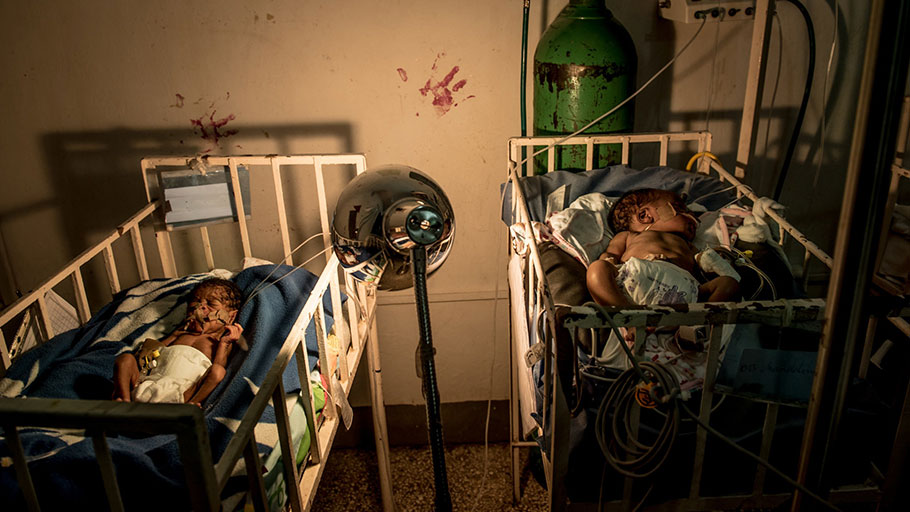
Newborns breathing with the help of oxygen tubes in the neonatal ward of Sainte Croix Hospital in Léogâne, west of Port-au-Prince. Hospitals are struggling with precarious supplies. Photograph by Meridith Kohut
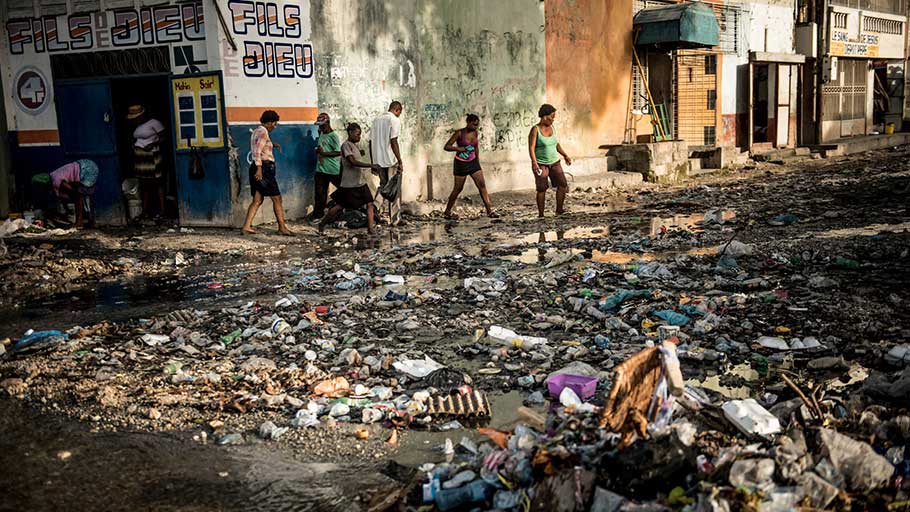
Trash piling up in Port-au-Prince, the capital, where many public services have collapsed. Photograph by Meridith Kohut
Gas shortages are worsening by the day. Hospitals have cut services or closed entirely. Public transportation has ground to a halt. Businesses have shuttered. Most schools have been closed since early September, leaving millions of children idle. Widespread layoffs have compounded chronic poverty and hunger. Uncertainty hangs over everything.
Many Haitians with the means to flee have left or are planning to, while most who remain are simply trying to figure out where they are going to get their next meals.
Haiti was once a strategic ally for the United States, which often played a crucial role here. During the Cold War, American governments supported — albeit at times grudgingly — the authoritarian governments of François Duvalier and his son, Jean-Claude Duvalier, because of their anti-Communist stance.
In 1994, the Clinton administration sent troops to restore Jean-Bertrand Aristide to power after his ouster as president, but 10 years later, intense pressure from the United States helped push Mr. Aristide out again.
Now, protesters are criticizing the United States for continuing to stand by Mr. Moïse. The Trump administration has urged respect for the democratic process, but has said little about the unrest in Haiti.
“If you look at Haitian history, governments are overthrown when the United States turns on them,” said Jake Johnston, a research associate at the Center for Economic and Policy Research.
The current crisis is a culmination of more than a year of violent protests, and the product, in part, of political acrimony that has seized the nation since Mr. Moïse, a businessman, took office in February 2017 following an electoral process that was marred by delays, allegations of voter fraud and an abysmal voter turnout.
Outrage over allegations that the government misappropriated billions of dollars meant for social development projects provided the initial impetus for the protests. But opposition leaders have sought to harness the anger to force his ouster, calling for his resignation and the formation of a transitional government.
The protests intensified in early September, at times turning violent and bringing the capital, Port-au-Prince, and other cities and towns around the country to a standstill.

Frustration with the government has mounted, leading to demonstrations like this one last week in the coastal town of Les Cayes. Photograph by Meridith Kohut
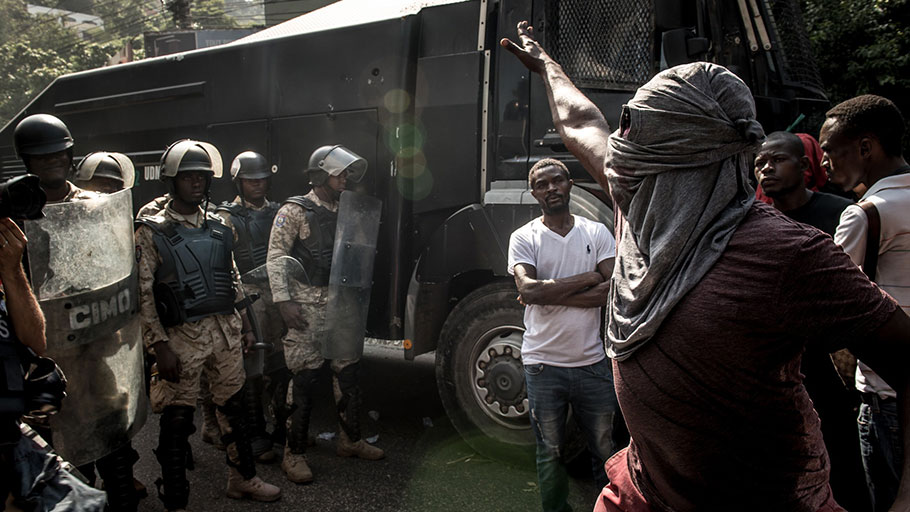
Confronting security forces in Port-au-Prince this month. Opposition leaders have sought to harness Haitians’ anger to force the resignation of President Jovenel Moïse. Photograph by Meridith Kohut
“We’re not living,” Destine Wisdeladens, 24, a motorcycle-taxi driver, said at a protest march in Port-au-Prince this month. “There is no security in the country. There’s no food. There’s no hospitals. There’s no school.”
Mr. Moïse has been defiant, saying in public comments last week that it would be “irresponsible” for him to resign. He has named a commission of politicians to explore solutions to the crisis.
Amid the current turmoil, daily routines, never a sure thing in this vulnerable country, have been thrown even more deeply into doubt.
With public transportation having ground to a halt, Alexis Fritzner, 41, a security guard making about $4 per day, walks about 10 miles each way to work at a clothing factory in Port-au-Prince. He has not been paid for more than a month, he said, yet he still goes to work for fear of being fired.
“It’s because there are no other options,” he said.
The mounting problems at Sainte Croix Hospital here in Léogâne are emblematic of the crisis. Though the town is only about 20 miles from Port-au-Prince, near-daily barricades have impeded traffic. Suppliers in the capital have been forced to close or have had trouble receiving imports, making medicine hard to get.
At least one patient at the hospital died in recent days because of a lack of crucial medicine, said the Rev. Jean Michelin St.-Louis, the hospital’s general manager.
It has been hard to wrangle fuel to run the hospital’s generators, its only power supply, he said. At times, ambulances have been blocked from crossing the barricades despite promises from protest leaders to the contrary. Some of the hospital’s staff members, including the chief surgeon, have not always been able to make it to work because of the protests.
“It’s the first time I’ve been through such a difficult experience,” Father St.-Louis, 41, said.
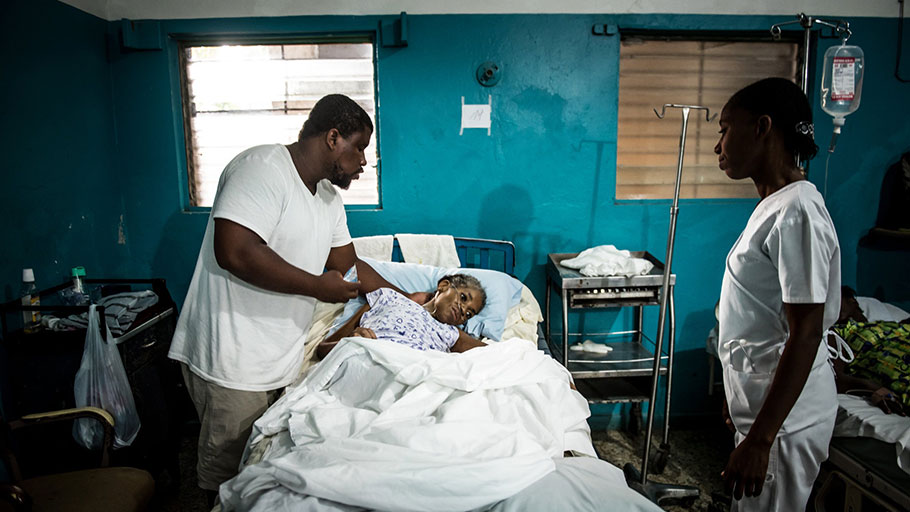
At Sainte Croix Hospital in Léogâne, patients like Gislaien Milord face dismal conditions. Recently the hospital was down to one day’s supply of oxygen, forcing difficult choices. Photograph by Meridith Kohut
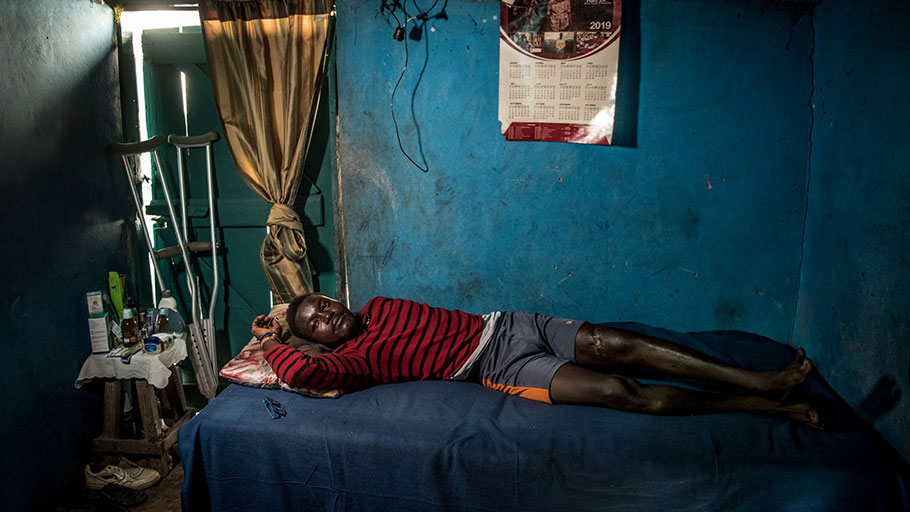
Lafontaine St. Fort says his leg was wounded by a police bullet during a demonstration. “The reason why I went to the protest was to make a better life for myself, and make a better country,” he said from his home in La Savane, a poor neighborhood in Les Cayes. Photograph by Meridith Kohut
The crisis is particularly stark in Les Cayes, the most populous city in southern Haiti, which has effectively been cut off from the capital by barricades on the main road.
The city endured a total blackout for nearly two months. The power company started to mete out electricity again earlier this month, though in tiny increments — a few hours on one day, a few more on another.
The city’s public hospital shut down recently when protesters, angry over the death of one of their comrades, smashed its windows and destroyed cars in its parking lot. After the attack, the staff fled, said Herard Marc Rocky, 37, the hospital’s head of logistics.
Even before the riot, the hospital was barely functioning. For three weeks, it had been without power after running out of fuel for its generators.
Archdeacon Lozama, 39, who oversees an Episcopal parish in Les Cayes, said demonstrators forbid him from holding services on two recent Sundays. “We couldn’t open the doors,” he said. “People would burn the church.”
Thieves have stolen the batteries from solar panels that provide electricity to the parish school. The keyboardist in the church music ensemble was recently wounded by a stray bullet. And protesters manning a barricade took food that Archdeacon Lozama was delivering by truck on behalf of an international charity.
“There’s no one you can call,” he lamented. “There’s no one in charge.”
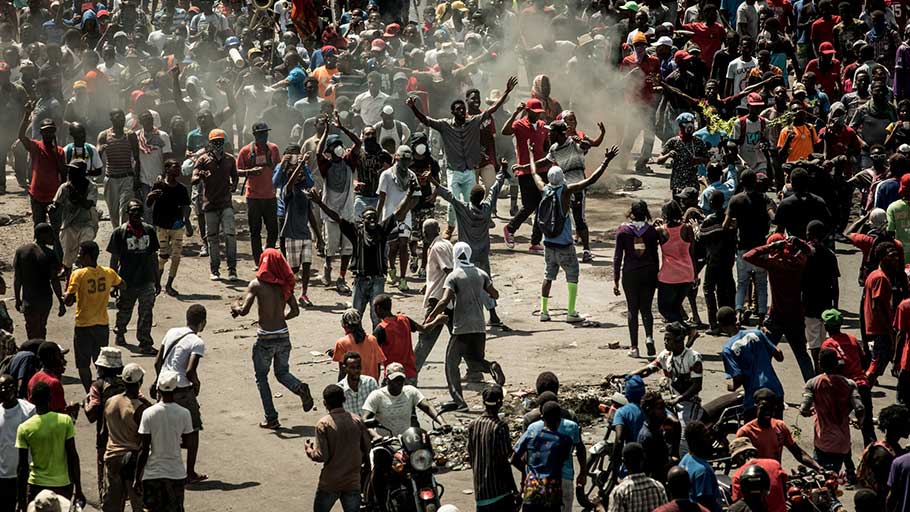
Street protests have intensified in recent months. The turnout can bring even Port-au-Prince to a standstill. Photograph by Meridith Kohut
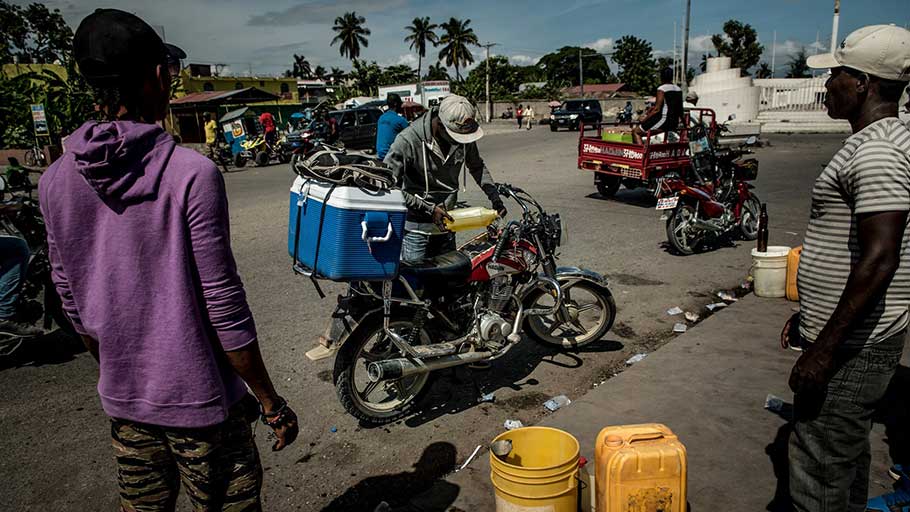
Gas shortages have worsened daily, one of many persistent problems hobbling already harsh lives. Photograph by Meridith Kohut
People, he said, are desperate. “As they have nothing, they can destroy everything. They have nothing to lose.”
Intersections throughout Les Cayes are scarred with the remains of burned barricades made with wood, tires and other debris, vestiges of near-daily protests.
“I’m hiding out here, I’m hunkering down, I’m not even on my porch,” said Marie Prephanie Pauldor Delicat, 67, the retired headmistress of a kindergarten in Les Cayes. “I’m scared of the people.”
Shop owners say sales have plummeted. Violent demonstrations have forced them to curtail their hours, and it has become harder to restock merchandise.
Several regional opposition leaders, in an interview at a dormant nightclub in Les Cayes, blamed infiltrators sympathetic to the government for the violence. But they defended the roadblocks, saying they helped thwart the movement of security forces accused of aggressions against residents.
“We get the support of the population despite it all, because all the population has the same demand: the departure of Jovenel Moïse,” said Anthony Cyrion, a lawyer.
A wellspring of opposition in Les Cayes is La Savane, one of its most forlorn neighborhoods, where simple, rough-hewed homes line unpaved roads and the stench of open sewers commingles with the salty perfume of the Caribbean Sea.
On a visit this month, reporters from The New York Times were surrounded by crowds of desperate and angry residents, each with a list of grievances against the government and accounts of utter despair.
One young man opened his shirt to reveal a bullet wound in his shoulder. Another showed where a bullet had hit his leg. They blamed the police.
“We are all victims in many ways!” shouted Lys Isguinue, 48. “We are victims under the sticks of the police! We are victims of tear gas! We are victims because we cannot eat! We are victims because we cannot sleep!”
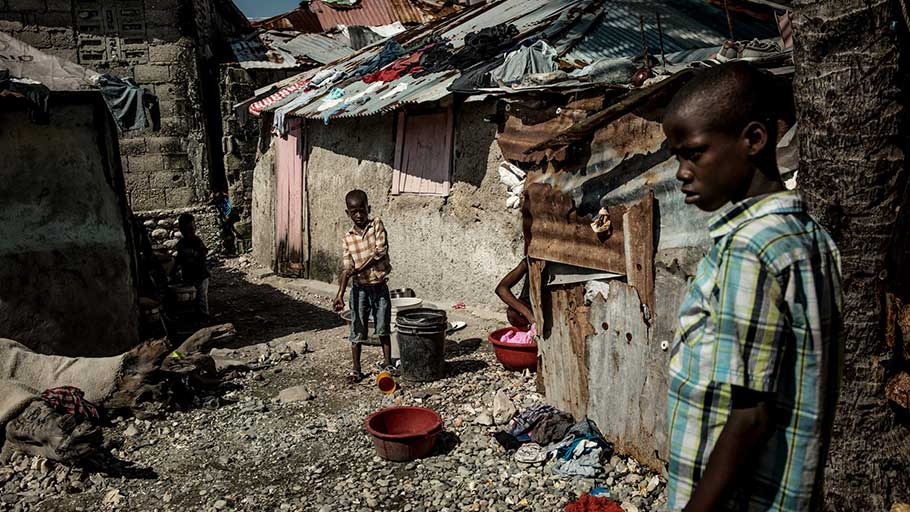
Much activity in Haiti has ground to a halt, with shops and schools closed, and incomes disastrously affected. Children in La Savane have been out of class since early September. Photograph by Meridith Kohut

Venise Jules fights complete despair, and the hope that propelled her to vote for Mr. Moïse has vanished. “He said everything would change,” she recalled. “We would have food on our plates, we would have electricity 24/7, we would have jobs for our children and salaries would increase.” Photograph by Meridith Kohut
Venise Jules, 55, a cleaning woman at a grade school and the mother of Ms. Molière, the unemployed secretary, said her entire family had voted for Mr. Moïse.
“He said everything would change,” she recalled. “We would have food on our plates, we would have electricity 24/7, we would have jobs for our children and salaries would increase.”
Ms. Jules, three of her five children and a cousin live in a narrow house in La Savane made from mud and stone. The corrugated metal roof leaks when it rains. The bathroom is an outhouse with a hole in the ground. With no running water, the family has to fill buckets at a public tap several blocks away.
They cook over coal — when they have something to cook.
“I didn’t put anything on the fire today,” Ms. Jules said. It had been a full day since she had eaten anything.
With the schools closed, Ms. Jules had been without work — or an income — for weeks. Even when she worked, earning $47 per month, she had not been able to amass any savings. Now she sends her children to eat at the homes of friends with something to spare.
Her despair, she said, has driven her to consider suicide.
On a recent evening, she sat with Ms. Molière, her daughter, in their house as it sank into the shadows of the night. Ms. Molière began to cry softly. Seeing her tears, Ms. Jules began to cry as well.
“It’s not only that we’re hungry for bread and water,” Ms. Molière said. “We’re hungry for the development of Haiti.”
“Haiti is very fragile,” she said.
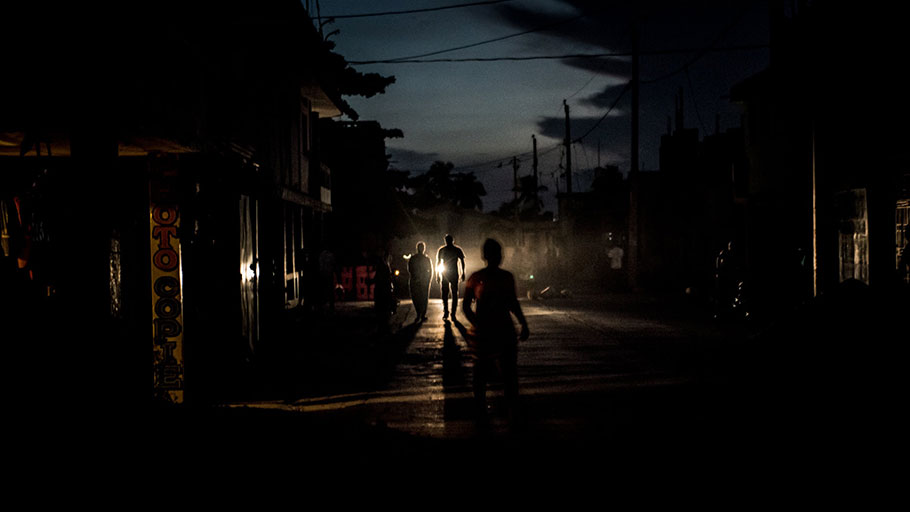
Blackouts in Les Cayes exacerbate people’s anxieties. “I’m hiding out here, I’m hunkering down, I’m not even on my porch,” said one woman fearful of what anger and desperation might drive people to do. Photograph by Meridith Kohut
Featured image: Protesters last week in Les Cayes, Haiti, surrounded a vehicle that had been burned in a previous demonstration. Impassable roads have contributed to the country’s emergency. Photograph by Meridith Kohut















